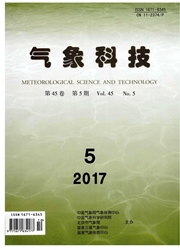

 中文摘要:
中文摘要:
利用区域中尺度模式ARPS(Advanced Regional Prediction System)模拟了华北西部复杂地形条件下发生在2010年9月1822日的降水过程,并针对云分析方法对降水和温度预报的影响开展了敏感性试验。结果表明:①模式在复杂地形下有很好的适用性。24h和48h模拟结果,降水的起止时间、落区以及强降水中心的位置均和实况一致。24h模拟降水的量级和实况接近,48h的比实况偏大;②模式能准确模拟温度的变化,插值得到的5天内6个台站温度预报的平均绝对误差只有2.69℃;③云分析能显著提高模式初值的质量,特别是其中水物质的含量,从而可显著改善48h强降水中心降水量偏大的状况,使模拟的降水场更接近于实况。但云分析对温度模拟结果的影响不明显。
 英文摘要:
英文摘要:
The Advanced Regional Prediction System model is used to simulate a precipitation case occurred from 18 to 22 September 2010 in the western North China complex topography. A set of sensitivity tests is also conducted to study the impact of cloud analysis on precipitation and temperature prediction. The results show: (1) The ARPS model for complex terrain has a very good adaptability. The comparison of ARPS prediction with local observation shows that ARPS performs very well both in start/stop time and spatial distribution of precipitation in two forecast process (24 h and 48 h) ; the precipitation of 24 h forecast corresponds with local observations, and the 48 h forecast tends to be bigger than local observations. (2) The ARPS model can also simulate temperature changes accurately, and the average absolute temperature error of interpolated 5-day forecast for six stations is only 2.69 ℃. (3) Cloud analysis can significantly improve the model initial field, especially the water substance, so that the bigger rainfall forecast at the strong precipitation center improved obviously, which indicates that the cloud analysis contributes to the success of precipitation forecasts, but the impact on temperature forecast is inconspicuous.
 同期刊论文项目
同期刊论文项目
 同项目期刊论文
同项目期刊论文
 Spatial Distributions and Seasonal Variations of Tropospheric Water Vapor Content over the Tibetan P
Spatial Distributions and Seasonal Variations of Tropospheric Water Vapor Content over the Tibetan P Cloud microphysical budget associated with torrential rainfall during the landfall of severe tropica
Cloud microphysical budget associated with torrential rainfall during the landfall of severe tropica An orthogonal terrain-following coordinate and its preliminary tests using 2-D idealized advection e
An orthogonal terrain-following coordinate and its preliminary tests using 2-D idealized advection e An investigation into the relationship between liquid water content and cloud number concentration i
An investigation into the relationship between liquid water content and cloud number concentration i Effects of Vertical Wind Shear, Radiation, and Ice Clouds on Precipitation Distributions During a La
Effects of Vertical Wind Shear, Radiation, and Ice Clouds on Precipitation Distributions During a La 期刊信息
期刊信息
